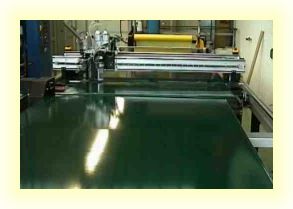| Spectrum Robotic Systems Ltd | ||
The 2002 series is a non-contact cutting method. Pure water is a very clean method which can be used to cut products in the food industry and materials which require a very clean environment. At the other end of the scale using an abrasive with the water allows metals up to 20mm Stainless Steel to be cut. The finish on the cut edge is exceptionally good and requires very little post cut finishing. Due to its abrasive action water can be used to cut glass, ceramics, marble and engraving of marble.
Typical applications include: Aerospace components, Metal cutting, Ceramics cutting, Stone cutting, Glass cutting, Marble cutting and carving, Plastics cutting and Shoemaking Overview This non-contact cutting method utilizes a concentrated stream of high-pressure water to cut through a wide range of materials. It is a system that is ideal for foodstuffs and others that require a clean environment. Using abrasive entrainment, it is also an excellent choice for cutting most metals such as stainless steel – up to 20mm thick. The process results in the need for very little or no post cut finishing. The operation of this system is the same as that of Spectrum’s other cutting systems. It features user friendly front-end software that makes production an extremely simple task. Utilizing on screen overlays and allowing varied setup configurations, relating to different cut jobs or materials, to be stored – the software saves time and effort which can be better spent elsewhere. Upon commencement of a cut, the software commands the motion system to move to the start position, and then follow the programmed cut path accurately to within 0.25mm. During operation, the required level of pressure is generated by the system’s high-pressure pump. In continuos operation, the high-pressure pump can work up to 3800 bar with a jet stream velocity of 800 m/s exiting the focusing nozzle. No further interaction is then required from the user until the cut is completed. Water is a naturally erosive force; examples of this can be seen in the removal of topsoil and the erosion of river canyons. In effect, water knife cutting simply uses these natural tendencies, concentrates and vastly increases the process – taking millions of years of natural erosion and performing a controlled technological equivalent in just a few seconds! For many years, materials such as honeycomb, fibre-reinforced and sandwich structures could not be cut efficiently. These types of materials are sensitive to high temperatures and machining stress, also earlier processes such as flame cutting and sawing would destroy the structure of such materials. Thermal processes such as laser cutting can instead cause burning and melting along the cut edge. All of which mean that water knife cutting is a seriously useful alternative in many cases.
|
||
|
||
